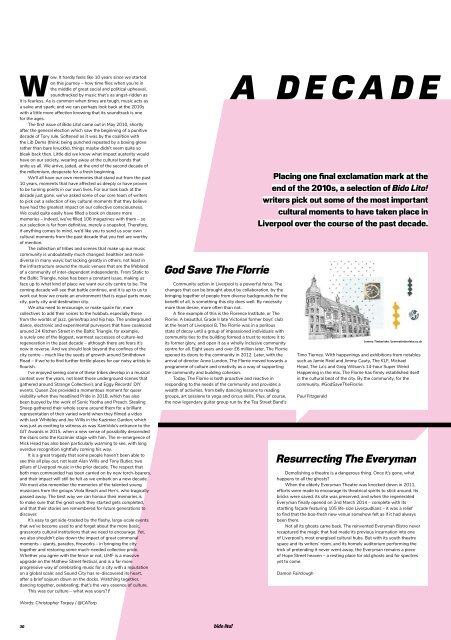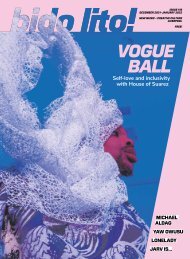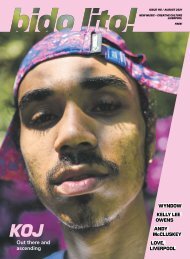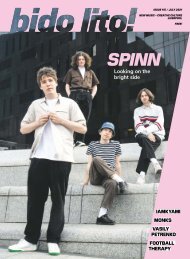Issue 106 / Dec 2019/Jan 2020
December 2019/January 2020 double issue of Bido Lito! magazine. Featuring: BEIJA FLO, ASOK, LO FIVE, SIMON HUGHES, CONVENIENCE GALLERY, BEAK>, STUDIO ELECTROPHONIQUE, ALEX TELEKO, SHE DREW THE GUN, IMTIAZ DHARKER and much more.
December 2019/January 2020 double issue of Bido Lito! magazine. Featuring: BEIJA FLO, ASOK, LO FIVE, SIMON HUGHES, CONVENIENCE GALLERY, BEAK>, STUDIO ELECTROPHONIQUE, ALEX TELEKO, SHE DREW THE GUN, IMTIAZ DHARKER and much more.
You also want an ePaper? Increase the reach of your titles
YUMPU automatically turns print PDFs into web optimized ePapers that Google loves.
Wow. It hardly feels like 10 years since we started<br />
on this journey – how time flies when you’re in<br />
the middle of great social and political upheaval,<br />
soundtracked by music that’s as angst-ridden as<br />
it is fearless. As is common when times are tough, music acts as<br />
a salve and spark; and we can perhaps look back at the 2010s<br />
with a little more affection knowing that its soundtrack is one<br />
for the ages.<br />
The first issue of Bido Lito! came out in May 2010, shortly<br />
after the general election which saw the beginning of a punitive<br />
decade of Tory rule. Softened as it was by the coalition with<br />
the Lib Dems (think: being punched repeated by a boxing glove<br />
rather than bare knuckle), things maybe didn’t seem quite so<br />
bleak back then. Little did we know what impact austerity would<br />
have on our society, wearing away at the cultural bonds that<br />
unite us all. We arrive, jaded, at the end of the second decade of<br />
the millennium, desperate for a fresh beginning.<br />
We’ll all have our own memories that stand out from the past<br />
10 years, moments that have affected us deeply or have proven<br />
to be turning points in our own lives. For our look back at the<br />
decade just gone, we’ve asked some of our core team of writers<br />
to pick out a selection of key cultural moments that they believe<br />
have had the greatest impact on our collective consciousness.<br />
We could quite easily have filled a book on dozens more<br />
memories – indeed, we’ve filled <strong>106</strong> magazines with them – so<br />
our selection is far from definitive, merely a snapshot. Therefore,<br />
if anything comes to mind, we’d like you to send us your own<br />
cultural moments from the past decade that you feel are worthy<br />
of mention.<br />
The collection of tribes and scenes that make up our music<br />
community is undoubtedly much changed: healthier and more<br />
diverse in many ways; but lacking greatly in others, not least in<br />
the infrastructure around the music venues that are the lifeblood<br />
of a community of inter-dependent independents. From Static to<br />
the Baltic Triangle, noise has been a constant issue, making us<br />
face up to what kind of place we want our city centre to be. The<br />
coming decade will see that battle continue, and it is up to us to<br />
work out how we create an environment that is equal parts music<br />
city, party city and destination city.<br />
We also need to encourage, or make space for, more<br />
collectives to add their voices to the hubbub, especially those<br />
from the worlds of jazz, grime/trap and hip hop. The underground<br />
dance, electronic and experimental purveyors that have coalesced<br />
around 24 Kitchen Street in the Baltic Triangle, for example,<br />
is surely one of the biggest, warmest successes of culture-led<br />
regeneration in the past decade – although there are fears it’s<br />
now in reverse. And we should look beyond the confines of the<br />
city centre – much like the seeds of growth around Smithdown<br />
Road – if we’re to find further fertile places for our noisy artists to<br />
flourish.<br />
I’ve enjoyed seeing some of these tribes develop in a musical<br />
context over the years, not least those underground scenes that<br />
gathered around Strange Collective’s and Eggy Records’ DIY<br />
events. Queen Zee provided a momentous moment for queer<br />
visibility when they headlined Pride in 2018, which has also<br />
been buoyed by the work of Sonic Yootha and Preach. Stealing<br />
Sheep gathered their whole scene around them for a brilliant<br />
representation of their varied world when they filmed a video<br />
with Jack Whiteley and Joe Wills in the Kazimier Garden; which<br />
was just as exciting to witness as was XamVolo’s entrance to the<br />
GIT Awards in 2015, when a new sense of possibility descended<br />
the stairs onto the Kazimier stage with him. The re-emergence of<br />
Mick Head has also been particularly warming to see, with long<br />
overdue recognition rightfully coming his way.<br />
It is a great tragedy that some people haven’t been able to<br />
see this all play out, not least Alan Wills and Tony Butler, two<br />
pillars of Liverpool music in the prior decade. The respect that<br />
both men commanded has been carried on by new torch-bearers,<br />
and their impact will still be felt as we embark on a new decade.<br />
We must also remember the memories of the talented young<br />
musicians from the groups Viola Beach and Her’s, who tragically<br />
passed away. The best way we can honour their memories is<br />
to make sure that the great work they started gets completed,<br />
and that their stories are remembered for future generations to<br />
discover.<br />
It’s easy to get side-tracked by the flashy, large-scale events<br />
that we’ve become used to and forget about the more basic,<br />
grassroots cultural institutions that we need to encourage. Yet,<br />
we also shouldn’t play down the impact of great communal<br />
moments – giants, parades, fireworks – in bringing the city<br />
together and restoring some much-needed collective pride.<br />
Whether you agree with the fence or not, LIMF is a massive<br />
upgrade on the Mathew Street festival, and is a far more<br />
progressive way of celebrating music for a city with a reputation<br />
on a global scale; and Sound City has re-discovered its heart,<br />
after a brief sojourn down on the docks. Watching together,<br />
dancing together, celebrating; that’s the very essence of culture.<br />
This was our culture – what was yours? !<br />
God Save The Florrie<br />
Community action in Liverpool is a powerful force. The<br />
changes that can be brought about by collaboration, by the<br />
bringing together of people from diverse backgrounds for the<br />
benefit of all, is something this city does well. By necessity<br />
more than desire, more often than not.<br />
A fine example of this is the Florence Institute, or The<br />
Florrie. A beautiful, Grade II late Victorian former boys’ club<br />
at the heart of Liverpool 8, The Florrie was in a perilous<br />
state of decay until a group of impassioned individuals with<br />
community ties to the building formed a trust to restore it to<br />
its former glory, and open it as a wholly inclusive community<br />
centre for all. Eight years and over £6 million later, The Florrie<br />
opened its doors to the community in 2012. Later, with the<br />
arrival of director Anne Lundon, The Florrie moved towards a<br />
programme of culture and creativity as a way of supporting<br />
the community and building cohesion.<br />
Today, The Florrie is both proactive and reactive in<br />
responding to the needs of the community and provides a<br />
wealth of activities, from belly dancing lessons to reading<br />
groups, art sessions to yoga and circus skills. Plus, of course,<br />
the now legendary guitar group run by the Tea Street Band’s<br />
A DECADE<br />
Placing one final exclamation mark at the<br />
end of the 2010s, a selection of Bido Lito!<br />
writers pick out some of the most important<br />
cultural moments to have taken place in<br />
Liverpool over the course of the past decade.<br />
Resurrecting The Everyman<br />
Demolishing a theatre is a dangerous thing. Once it’s gone, what<br />
happens to all the ghosts?<br />
When the elderly Everyman Theatre was knocked down in 2011,<br />
efforts were made to encourage its theatrical spirits to stick around. Its<br />
bricks were saved, its site was preserved, and when the regenerated<br />
Everyman finally opened on 2nd March 2014 – complete with its<br />
startling façade featuring 105 life-size Liverpudlians – it was a relief<br />
to find that the box-fresh new venue somehow felt as if it had always<br />
been there.<br />
Not all its ghosts came back. The reinvented Everyman Bistro never<br />
recaptured the magic that had made its previous incarnation into one<br />
of Liverpool’s most energised cultural hubs. But with its youth theatre<br />
space and its writers’ room, and its homely auditorium performing the<br />
trick of pretending it never went away, the Everyman remains a piece<br />
of Hope Street heaven – a resting place for old ghosts and for spectres<br />
yet to come.<br />
Damon Fairclough<br />
Timo Tierney. With happenings and exhibitions from notables<br />
such as Jamie Reid and Jimmy Cauty, The KLF, Michael<br />
Head, The La’s and Greg Wilson’s 14-hour Super Weird<br />
Happening in the mix, The Florrie has firmly established itself<br />
in the cultural beat of the city. By the community, for the<br />
community. #GodSaveTheFlorrie.<br />
Paul Fitzgerald<br />
Jemma Timberlake / jemmatimberlake.co.uk<br />
Words: Christopher Torpey / @CATorp<br />
30

















